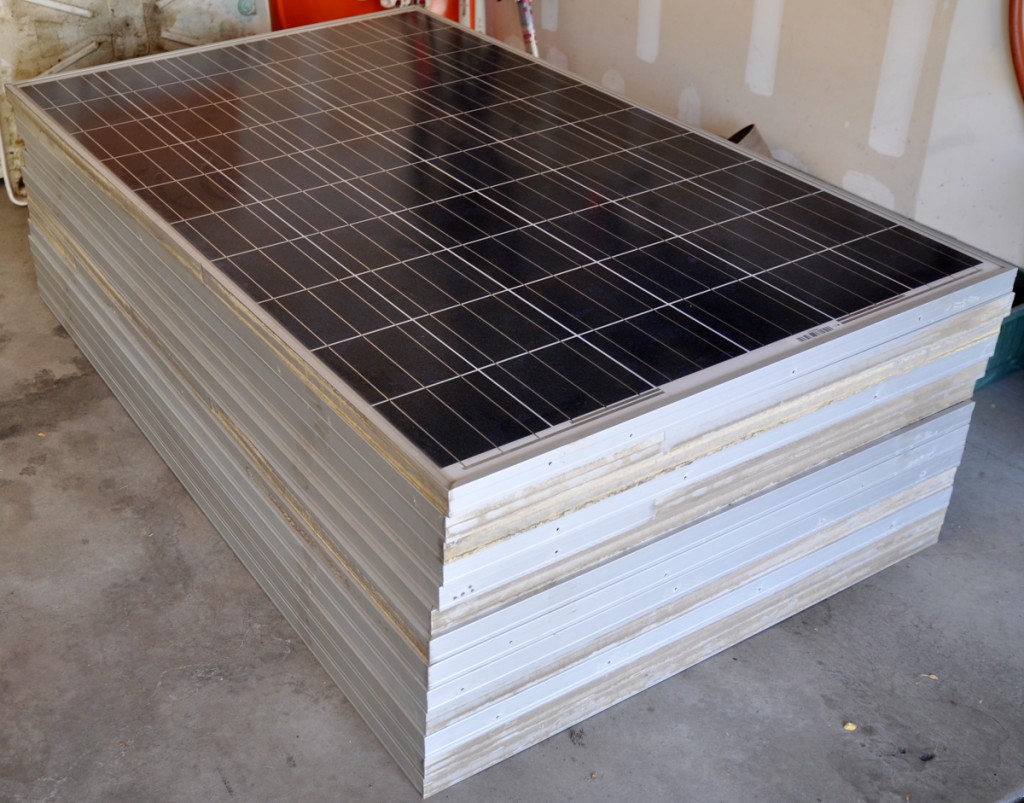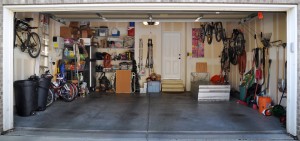Given the success of the global climate talks in Paris, it’s time to post a hyper-local piece on our household’s greatest carbon-mitigation endeavor: our solar panels.
Specifically, I got a wild hair to compare the volume occupied by the stack of solar panels to the volume of the coal that wasn’t incinerated thanks to their non-garage-based efforts over the past five-plus years.
I can do this because, thanks to a wicked hailstorm in June, we needed a new roof, which in turn meant our solar panels had to come off temporarily. They’ve been off since late October now, collecting very little sunlight where I’d typically park in our two-car garage (Denver’s roof inspectors face a crazy backlog, which today’s ten inches of snow is not helping). But this allowed me to actually measure this block of solar panels and, out of curiosity, figure out how much coal they’ve spared.
Our east-southeast-facing, 2.86 kilowatt system (thirteen 220-watt REC Solar modules) generated 20,597 kilowatt hours of electricity from the time it went live on July 21, 2010 through their removal on Oct. 14, 2015.
Local utility Xcel Energy’s 2014 fuel mix in Colorado was as follows:
| 18.90% | wind |
| 1.20% | solar |
| 1.70% | hydro |
| 0.00% | biomass |
| 52.70% | coal |
| 25.30% | natural gas |
Note wind number — big. Solar is way up from just a few years ago, too, but still a rounding error.
Focusing on coal, multiplying the kilowatt hours the panels generated by the percentage of coal in Xcel’s Colorado energy mix, the panels displaced 10,855 kilowatt hours of coal-fired electricity. The U.S. Energy Information Administration estimates that it takes about 1.05 pounds of coal to generate one kilowatt hour of electricity, so that’s 11,374 pounds/5,170 kilograms/2.58 metric tons. (Note that, assuming coal is almost all carbon, burning it would amount to about 3.6 times that weight in carbon dioxide, thanks to the two Os hooking up with each of those liberated Cs).

Five cubic yards, in dirt form (courtesy Guins Yard)
Assuming 337 cubic centimeters of bituminous coal per pound (trust me), we get 135.4 cubic feet, or, thankfully, almost precisely 5 cubic yards of coal that wasn’t burned.
The panels themselves, stacked and parked in the garage, consume 1.07 cubic yards.
So: the panels have saved four times their volume in coal over their lifetime. They will, assuming they don’t degrade too much over their 20-year lifespan and that Xcel doesn’t continue to cut back on coal (this assumption, I hope, proves false) obviate their volume in burned coal — a cubic yard — every year they silently produce. That does’t count the roughly 10,000 cubic feet of natural gas they aren’t burning every year.
So good on ya, solar panels. And get on back up to the roof so I don’t have to keep scraping snow and ice from the car in the morning.
A couple of final notes:
- I’m not sure if the EIA’s coal-to-electricity calculations include transmission and distribution losses or not. Looks like it accounts for about 6 percent of actual power generation in the United States, according to the World Bank.
- The solar panels are not actually ours: they belong to Sunrun, which we pay $39 a month. This doesn’t count the $2,800 that vanished pretty much immediately after Sunrun’s IPO cratered from the $14-a-share at which we pre-IPO customers were so kindly offered to invest to the $7 range after hitting the NASDAQ (it has since rebounded somewhat). I find this a curious approach to building customer satisfaction, but the service itself has been great, and I still very much recommend them as a solar provider (just maybe not as an investment vehicle, but who knows).
- Because Sunrun took ownership of the RECs (renewable energy credits) up front and most surely sold them to a utility who most likely used them as an excuse not to install renewable-energy capacity equal to that of our panels’ generation, it’s not clear that we technically saved any coal at all. (Because, the argument goes, had the utility not bought the RECs, it would have had to install its own renewable energy. But that’s a glass-half-empty view, isn’t it?)



2 Comments
My solar panels save their volume in coal every year: https://t.co/BbaTEjvoB4 #solarenergy @sunrun #climatechange
I never left a note when occasionally visiting your blog. I like to mix up some Denver memories with daily news and global issues which brings me here now and then. Say Hi to your three ladies as well! Greetings from Bonn (almost). Heidi & co
Comments are closed.